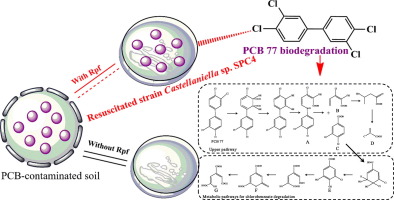当前位置:
X-MOL 学术
›
Sci. Total Environ.
›
论文详情
Our official English website, www.x-mol.net, welcomes your feedback! (Note: you will need to create a separate account there.)
Aerobic degradation of 3,3',4,4'-tetrachlorobiphenyl by a resuscitated strain Castellaniella sp. SPC4: Kinetics model and pathway for biodegradation.
Science of the Total Environment ( IF 8.2 ) Pub Date : 2019-06-24 , DOI: 10.1016/j.scitotenv.2019.06.364 Xiaomei Su 1 , Si Li 1 , Jiafang Cai 1 , Yeyuan Xiao 2 , Linqin Tao 1 , Muhammad Zaffar Hashmi 3 , Hongjun Lin 1 , Jianrong Chen 1 , Rongwu Mei 4 , Faqian Sun 1
Science of the Total Environment ( IF 8.2 ) Pub Date : 2019-06-24 , DOI: 10.1016/j.scitotenv.2019.06.364 Xiaomei Su 1 , Si Li 1 , Jiafang Cai 1 , Yeyuan Xiao 2 , Linqin Tao 1 , Muhammad Zaffar Hashmi 3 , Hongjun Lin 1 , Jianrong Chen 1 , Rongwu Mei 4 , Faqian Sun 1
Affiliation

|
Resuscitated strains which were obtained by addition of resuscitation promoting factor (Rpf) could provide a vast majority of microbial source for obtaining highly efficient polychlorinated biphenyl (PCB)-degrading bacteria. In this study, the Castellaniella sp. strain SPC4 which was resuscitated by Rpf addition showed the highest efficiency in degradation of 3,3',4,4'-tetrachlorobiphenyl (PCB 77) among the resuscitated and non-resuscitated isolates. Further investigations on the PCB 77 degradation capability of the resuscitated strain SPC4 showed that SPC4 could efficiently degrade PCB 77 with maximum degradation rate (qmax) of 0.066/h at about 20 mg/L of PCB 77. The maximum growth rate on PCB 77 was 2.663 × 107 CFU/(mL·h) (0.024/h). The most suitable model of Edward demonstrated that the SPC4 could achieve qmax of 0.9315/h, with substrate-affinity of 11.33 mg/L and substrate-inhibition constants of 11.41 mg/L. Meanwhile, the presence of bphA gene expression and chlorine ions release, together with the identification of metabolites, confirmed that the bph-encoded biphenyl pathway was involved in PCB 77 mineralization by SPC4. This report is the first to demonstrate aerobic degradation of PCB 77 by the resuscitated strain Castellaniella sp. SPC4, indicating excellent potential for PCB bioremediation.
中文翻译:

复苏的Castellaniella sp。菌株对3,3',4,4'-四氯联苯的有氧降解。SPC4:动力学模型和生物降解途径。
通过添加复苏促进因子(Rpf)获得的复苏菌株可以为获得高效降解多氯联苯(PCB)的细菌提供绝大多数微生物来源。在这项研究中,Castellaniella sp.。通过添加Rpf复苏的SPC4菌株在3,3',4,4'-四氯联苯(PCB 77)的降解中表现出最高的降解效率。对复苏的菌株SPC4的PCB 77降解能力的进一步研究表明,在大约20 mg / L的PCB 77下,SPC4可以有效降解PCB 77,最大降解速率(qmax)为0.066 /h。PCB77的最大生长速率为2.663×107 CFU /(mL·h)(0.024 / h)。最合适的Edward模型表明SPC4可以达到0.9315 / h的qmax,底物亲和力为11.33 mg / L,底物抑制常数为11.41 mg / L。同时,bphA基因表达和氯离子释放的存在,以及代谢物的鉴定,证实了bph编码的联苯途径与SPC4的PCB 77矿化有关。该报告是第一个证明复苏的卡斯特氏菌(Castellaniella sp。)引起的PCB 77有氧降解的报告。SPC4,表明PCB生物修复的潜力非常大。该报告是第一个证明复苏的卡斯特氏菌(Castellaniella sp。)引起的PCB 77有氧降解的报告。SPC4,表明PCB生物修复的潜力非常大。该报告是第一个证明复苏的卡斯特氏菌(Castellaniella sp。)引起的PCB 77有氧降解的报告。SPC4,表明PCB生物修复的潜力非常大。
更新日期:2019-06-24
中文翻译:

复苏的Castellaniella sp。菌株对3,3',4,4'-四氯联苯的有氧降解。SPC4:动力学模型和生物降解途径。
通过添加复苏促进因子(Rpf)获得的复苏菌株可以为获得高效降解多氯联苯(PCB)的细菌提供绝大多数微生物来源。在这项研究中,Castellaniella sp.。通过添加Rpf复苏的SPC4菌株在3,3',4,4'-四氯联苯(PCB 77)的降解中表现出最高的降解效率。对复苏的菌株SPC4的PCB 77降解能力的进一步研究表明,在大约20 mg / L的PCB 77下,SPC4可以有效降解PCB 77,最大降解速率(qmax)为0.066 /h。PCB77的最大生长速率为2.663×107 CFU /(mL·h)(0.024 / h)。最合适的Edward模型表明SPC4可以达到0.9315 / h的qmax,底物亲和力为11.33 mg / L,底物抑制常数为11.41 mg / L。同时,bphA基因表达和氯离子释放的存在,以及代谢物的鉴定,证实了bph编码的联苯途径与SPC4的PCB 77矿化有关。该报告是第一个证明复苏的卡斯特氏菌(Castellaniella sp。)引起的PCB 77有氧降解的报告。SPC4,表明PCB生物修复的潜力非常大。该报告是第一个证明复苏的卡斯特氏菌(Castellaniella sp。)引起的PCB 77有氧降解的报告。SPC4,表明PCB生物修复的潜力非常大。该报告是第一个证明复苏的卡斯特氏菌(Castellaniella sp。)引起的PCB 77有氧降解的报告。SPC4,表明PCB生物修复的潜力非常大。






































 京公网安备 11010802027423号
京公网安备 11010802027423号